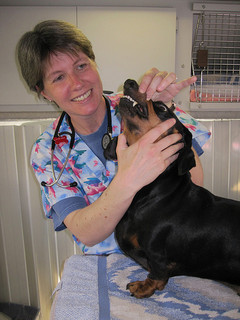
Learning your beloved dog has a disease can be heartbreaking. What’s worse is finding out the disease could have been prevented. Whether it’s through vaccination, preventive petmeds, or certain actions on your part, caring for your dog and keeping him healthy involves much more than food, water, and affection. Here are three common dog diseases, how they’re contracted, and how they can be prevented.
Heartworm
As the name suggests, a heartworm is a worm that attacks a dog’s heart. If left untreated, heartworm can result in your dog’s death. When a dog is infected with heartworm, it’s important to catch it as early as possible, but it’s even easier to prevent it altogether.
Heartworm is transmitted via mosquito bites. Here’s how it works: An animal is infected with heartworm. The female heartworm deposits her young into the animal’s bloodstream. A mosquito bites the infected animal, taking in the young heartworms. While inside the mosquito, they develop into infective larvae. When the mosquito bites another animal—like your dog—those larvae enter through the bite wound, infecting the new animal. They travel to the heart, and begin to grow, reaching maturity in about six months. Then the cycle starts all over again.
It’s impossible to prevent your dog from being bitten by mosquitoes. If he spends any time outside, it’s going to happen at one point or another. But by giving your dog a heartworm preventive on a regular basis (usually monthly), you can keep him from becoming infected. When a carrier mosquito bites your dog, the worms it deposits will die in the dog’s bloodstream before they even reach the heart.
Heartworm preventives can also kill larvae within the heart, but if your dog already has heartworm, medication administration must be monitored by a vet to prevent damaging the heart. Have your dog tested for heartworm at least once a year. Your vet will require it in order to prescribe the preventive anyway. Be sure to stick to a schedule for giving your dog the preventive by adding reminders to your calendar. Missing even one dose makes your dog vulnerable to these nasty parasites.
Canine Distemper
A particularly insidious disease, canine distemper is caused by a virus, and there is no cure. Because it’s viral in nature, dogs are more vulnerable to it, especially when they’re exposed to other dogs at kennels, grooming salons, and dog parks, for example. The disease is quite serious, causing damage to the respiratory, gastrointestinal, nervous, and urogenital systems. Symptoms include a high fever, watery discharge from the eyes and nose, and red eyes. As the disease progresses, a dog with distemper will become lethargic, suffer from vomiting, diarrhea, and a persistent cough, and may stop eating altogether. Finally, as the disease begins to attack the nervous system, an infected dog may begin having seizures, experience paralysis, and have attacks of hysteria.
The best way to prevent canine distemper is to have your dog vaccinated against the virus on a regular basis. Newborn puppies and older dogs are more susceptible to distemper if they haven’t been vaccinated. If you suspect your dog may have distemper, take him to the vet so he can receive proper treatment, and be kept as comfortable as possible. While it’s incurable through the use of medication, some dogs do recover from distemper.
Dental Disease
Dogs don’t get cavities the way humans do. But if their teeth don’t receive proper care, dogs can develop gingivitis, a painful and dangerous inflammation and receding of the gums. If allowed to progress, gingivitis can cause infection and gum loss, as well as destruction of the dental supporting structures. Eventually, it can lead to periodontal disease, which can cause tooth loss, and irreversible damage to the dog’s teeth and gums, requiring invasive procedures and even surgery. Before your dog gets the point of suffering periodontal disease, and to avoid the costs that come with treating a serious disease, you can take steps to prevent dental disease in your dog.
Ask your vet to perform an oral exam each time you take your dog in for an appointment. A vet may be able to identify issues you’ve missed, and can help you treat them before they get worse. At home, you can brush your dog’s teeth on a daily, or at least weekly basis. Pet supply stores sell a variety of canine toothbrushes and toothpaste. The earlier you begin doing this with your dog, the better. As a puppy, your dog will become used to the brushing, and will be more cooperative. If you’re starting with an older dog who isn’t keen on the idea, you may ask your groomer to perform the brushing for you.
Make sure you’re feeding your dog healthy food and treats that assist with dental health. Canned food all the time isn’t the best option. Dry, crunchy food and biscuits have a brushing effect on the teeth, and can help dislodge tartar before it builds and causes gingivitis. These foods are not replacements for the actual brushing, though.
Finally, provide your dog with toys and chews that help keep his teeth clean. Chews that have small nubs on them can help reduce tartar buildup, not to mention they just feel good on your dog’s teeth and gums. Fleecy toys can also help keep teeth clean, and provide fun and distraction for your dog.
With a few simple precautions—vaccinations, preventive medications, and hygienic care—you can prevent these common dog diseases, and avoid much more serious complications. You and your dog will both be much happier.
Jackie Roberts is a writer for 1-800-PetMeds, and loves to help and support the pet community. You can find Pet Meds on Twitter or connect with Pet Meds on Facebook.
